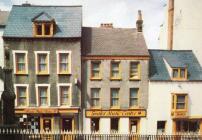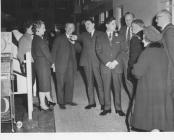Content can be downloaded for non-commercial purposes, such as for personal use or in educational resources.
For commercial purposes please contact the copyright holder directly.
Read more about the The Creative Archive Licence.
Description
Denomination: Anglican
Dedication: St Cadog
Built: 14th century
Photography: John Ball
Date: 25 September 2002
Camera: Sigma SA-300 35 mm SLR
Notes:
1. There are several windows with cusped Y-tracery in the 14th century long single chamber restored in 1870. The piscina or stoup is Late Norman, the font is 13th century, the pulpit sounding board contains parts of the old screen, the porch has a 16th century carved bargeboard, and there is an early Christian stone. [Extracted from: The Old Parish Churches of Mid Wales by Mike Salter, Folly Publications, Malvern 2003; ISBN 1-871731-62-3]
2. St Cadog's church is a small, simple structure on the southern edge of the Usk Valley some 3 km west of Brecon. Medieval fabric survives, and together with remnants of the original fenestration, may date to the early 14th century. The church contains a medieval font and piscina as well as a fine range of 18th century memorials. The churchyard was originally larger, perhaps D-shaped; it has an early medieval cross-inscribed pillar stone set up in it to the south of the church. Nave and chancel walls appear to be partially rebuilt, notably at east end of north wall and upper courses of south wall; east wall appears uniform and may be wholly reconstructed or perhaps just the upper part. West wall has inserted window but some original masonry. Totally re-roofed. Two or perhaps three of the windows retain some medieval dressings; north doorway is original; porch is exceptional for its facade. [Extracted from the Clwyd-Powys Archaeological Trust (CPAT) website, where the full text is available]
3. Theophilus Jones (1809):
The church, dedicated to Saint Cattwc, is situated close to the turnpike road, two miles due west of Brecon, and is therefore correctly laid dawn in latitude 52 1, longitude 3 23. The church is not ceiled, but is well flagged, and the seats are regular and in good repair: it consists of a nave only, and at the west end, on the outside, is a small shed containing one bell. At the extreme verge of the churchyard is a headstone to the memory of William Williams, who died pitifully, 1791, aged 28: he was bitten by a mad dog, and died of the hydrophobia... [Extracted from: The History of Brecknockshire by Theophilus Jones, first published 1809]
4. Edwin Poole (1886):
The church is dedicated to St. Cattwg, and is surrounded by fourteen stately yew trees, one of which when measured was found to be twenty-seven feet in girth. Llanspyddyd church, which, until a few years ago was one of the oldest unrestored churches in the county, was, by the munificence of the parishioners and landowners, restored and reopened on July 9th, 1880, by the Lord Bishop of the Diocese. The restorative work cost £800, and the church is now one of the most comfortable country churches in the county. It contains beautiful and chaste stained-glass windows in the eastern and western protions, commemorative scions of the families of Ffrwdgrech (Col. Pearce) and the Morgans of Bolgoed. . . Another grave there . . . is that of the Brecknock poet, the late Richard Hall, who lies buried under the shade of one of the yew trees. Mr Hall's volume of poetry, "Tales of the Past and other Poems", is now very scarce. The [parish] register dates back to 1699. On the south side of the church is a very old stone, which is alleged to mark the spot where either Brychan Brycheiniog, Prince of Brecknock, lies buried, or Aulach his father. . . There is no inscription, but there is a rude cross within a ring, and there are also three other smaller rings. The stone is believed to be one of the oldest of its kind in the county. [Extracted from: The Illustrated History and Biography of Brecknockshire by Edwin Poole, published 1886 by the author]
5. A double west bell cote containing a single bell hung for chiming in the north aperture. No inscription was visible [in 1977] and the bell probably dates fromthe second half of the 19th century. The church was re-roofed and a new bellcote provided in 1870 and the bell is consistent with that date. The lack of ropes was presented in 1700, implying more than one bell, while in 1709 it was presented '... the bell broken and a new one wanting'. [Extracted from: The Church Bells of Breconshire by John C. Eisel, Logaston Press, Almeley, 2002; ISBN 1-873827-23-7]
Image 3:
Two late 18th century memorial tablets attached to the south wall of the church.
A complete listing of monumental inscriptions is available on the Llanspyddid website.










Do you have information to add to this item? Please leave a comment
Comments (0)
You must be logged in to leave a comment